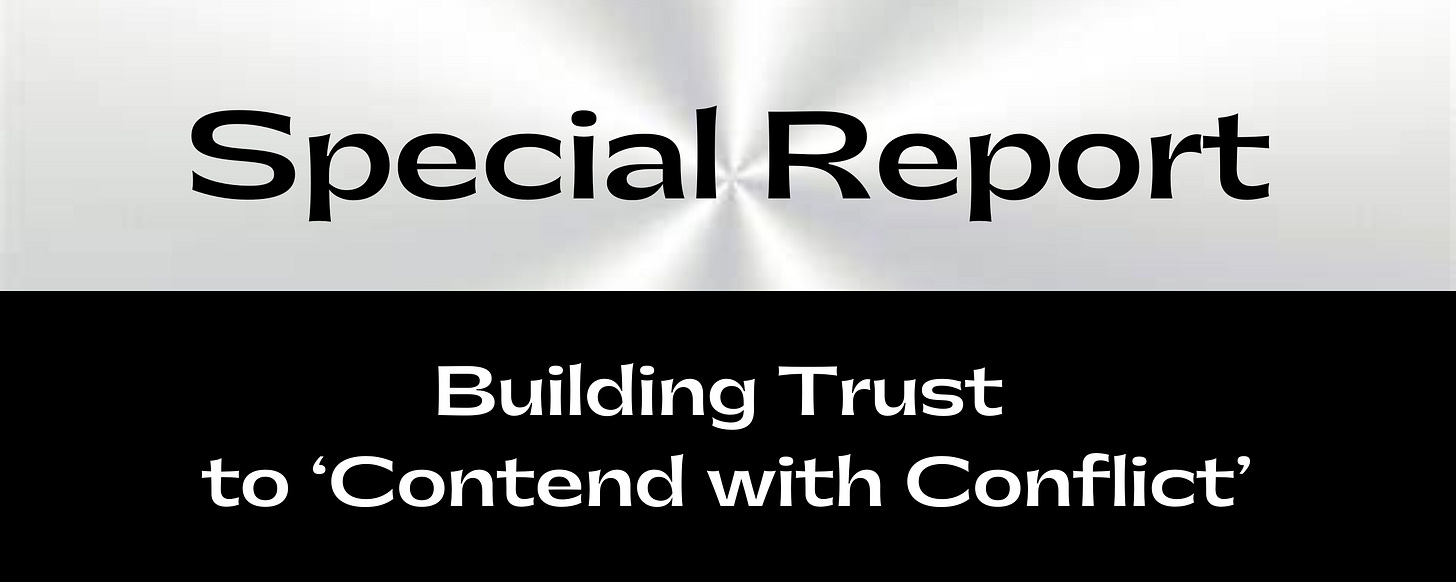Why Building Trust is Necessary to 'Contend with Conflict'
A two-question discussion with 5 professionals

Patrick Lencioni’s book “The Five Dysfunctions of a Team: A Leadership Fable,” has been a best-seller and considered a leadership handbook for executives, managers and organizations. One point that he made is the focus of this roundtable special report.
“You have to be able to build trust so you can meaningfully contend with conflict.
“If you can productively navigate conflict, you can get to real commitment,”
Lencioni wrote. “Not malicious compliance.”
Trust building is a prerequisite to earning credibility and buy-in, especially when conflict arises or is discovered to be entrenched.
“Like it or not, all teams are potentially dysfunctional. This is inevitable because they are made up of fallible, imperfect human beings,” Lencioni wrote.
“From the basketball coach to the executive suite, politics and confusion are more the rule than the exception.”
Leaders know conflict can be a productive road or a suboptimal or destructive one. Relationship quality plays a role in how effective the problem solving .
“Facing dysfunction and focusing on teamwork is particularly critical at the top of an organization because the executive team sets the tone for how all employees work with one another,” Lencioni wrote.
The good news, he asserted, is that, “Counter to conventional wisdom, the causes of dysfunction are both identifiable and curable.”
DYSFUNCTION #1: ABSENCE OF TRUST
The fear of being vulnerable with team members prevents building of trust within the team.
DYSFUNCTION #2: FEAR OF CONFLICT
The desire to preserve artificial harmony stifles the occurrence of productive, ideological conflict.
DYSFUNCTION #3: LACK OF COMMITMENT
The lack of clarity or buy-in prevents team members from making decisions they will stick to.
DYSFUNCTION #4: AVOIDANCE OF ACCOUNTABILITY
The need to avoid interpersonal discomfort prevents team members from holding one another accountable for their behaviors and performance.
DYSFUNCTION #5: INATTENTION TO RESULTS
The pursuit of individual goals and personal status erodes the focus on collective success.
Two Questions for 5 Sources
"Malicious” compliance is dangerous as a perceived, reliable substitute for agreement.
Yet “why, specifically” is the curiosity and question, considering it is often the norm.
“One time, my manager instructed an employee to ‘only follow written procedures,’ without exception,” recalls Harrison Tang, the co-founder and CEO at Spokeo, a people search engine.
“The employee knew that the task required flexibility, but instead of speaking up, they strictly followed the rule, fully aware that it would cause delays and mistakes.”
The results were predictable.
“This led to a significant problem, as the task was not completed efficiently,” Tang says. “The employee’s rigid adherence to the rule was not intended to improve the process but rather to expose flaws in the instruction. As a result, the project was delayed and frustration grew between the employee and the manager.”
The employee that Tang talked about decided not to professionally argue their point so they decided to make one covertly, with evidence — not exactly what the manager expected or wanted. Examining what occurred from a dissatisfied or frustrated team member’s perspective is helpful for understanding.
“Malicious compliance is a passive aggressive behavior,” says Connor McClenahan, Psy.D., a clinical psychologist at Here Counseling, a private practice primarily assisting lawyers and certified public accountants (CPAs) who often need help navigating the emotional issues that arise in their work environments.
“The person privately, or even unconsciously, uses compliance to communicate their belief that they're being treated unfairly or they weren't listened to.”
Forced compliance is more likely to lead to outbreaks of problems with some people.
“It's risky because unlike open conversation, passive aggressive behavior is difficult to confront and can spiral into larger conflicts, costly energy and resources in recovering from the lost productivity and trust.”
What leaders are after may not emerge from compliance-focused efforts when conflict is forming or is occurring.
“Real commitment requires open conversation and patience,” McClenahan states. “Though it can feel frustrating and unfair for managers to listen more intently to an employee who is expressing malicious compliance, it is the most efficient and healthy way to avoid further problems.”
“Think of it this way,” says Margaret Ricci, founder and CEO at Cultural Strategies, a company that uses scientific analysis to heal bad relationships between team members. “‘Malicious compliance’ is, in effect, saying out-loud, ‘Yes’ when everything inside the person’s head is saying, ‘No stinkin’ way!'“
“In their head, they are already thinking of ways to sabotage whatever is trying to be built or gained. The trust level of these two — or more — individuals is at such a low point that it cannot move up the scale unless something dramatic changes. Right now, there is no trust between these people.”
That’s a treacherous place in a relationship.
“Once trust is lost, it takes 2X or 3X the amount of goodwill to rebuild it,” Ricci says.
”It also means diving into the earlier problems.”
What appears to look, sound and feel like a positive sign for leaders, she says, is not as good as it appears.
“This is why we don’t want to have consensus,” Ricci says. More on this later.
“Malicious compliance when resolving conflicts will never lead to sustainable positive results” says Iqbal Ahmad, an entrepreneur and director at the Britannia School of Academics, an online training course company, “and will be counterproductive in maintaining harmony and peace,” he adds.
It’s a dangerous approach on which to depend, Ahmad stresses.
“If either or both parties in the conflict agree to a resolution half-heartedly but do not accept the outcome, it will create a toxic environment in which further dysfunctional conflicts will take place,” he says.
“Real commitment, in contrast, will mean that the parties are able to put aside their differences to accept the outcome in the best interest of the organization — and for the sake of their own professional image.”
Forceful compliance can’t be depended on, says Ryan Anderson, the president at Markiserv, a graphic design agency, “because it is not being derived from true bonding or connection, but generally out of fear, pressure or conflict avoidance.”
Future issues should be expected.
“This tailwinds further down the line in the relationship that will impact how the individual you had a conflict with perceives, interacts and trusts you,” Anderson says.
The risks are greater than leaders might foresee.
“Generally, unless there is true trust or bonding, compliance under malicious intent will be to save face, and that specific individual will generally not be one to rely upon in high pressure situations, or when there are other options for that individual to take like finding another job, another friend or life partner,” Anderson points out.
In this second and final section, this report will look at trust building, conflict repairs and the maintenance of trust as vitally important precursors to successfully meet — and work through — conflict for the benefit of multiple stakeholders and the whole.
“I have read Patrick Lencioni’s book ‘The Five Dysfunctions of a Team,’” Tang says, “and it was one of the most impactful books that guided me in managing conflicts within my organization.
“I firmly believe that trust enables honest communication.”
He elaborates, to detail what has learned in his role in the company.
“If an employee does not trust that I will listen to their concerns without reacting harshly or firing them, they will likely stay silent,” Tang says.
“This lack of open dialogue can lead to workplace toxicity, ultimately giving rise
to conflicts,” Tang adds.
“By fostering trust, we create an environment where employees feel safe to speak up, leading to healthier workplace dynamics and more effective conflict resolution.”
Leaders may forget in professional contexts how important that this concept is to collaboration, harmony and the outcomes for which they are striving.
“Trust is the foundation of any relationship,” McClenahan says.
“A good analogy is a bridge: in order for the bridge to hold any weight, the struts need to work together to carry the load.
“While on the outside, a team composition might look healthy — with individuals who have a history of high performance — the ability to hold together under the weight of external stress determines the strength of a team.”
It’s invaluable when people learn to believe in each other’s conduct and character.
“Trust building is about safety,” McClenahan says. “It means building safety to freely express discontent, frustration and alternative positions without fear of being ostracized.
“Strong teams welcome and affirm alternate positions as a way to build the strength to push through difficult challenges and achieve more rewarding goals together,” McClenahan adds.
It’s not only about being able to work with conflict but how people feel about issues and each other afterward.
“Trust helps to build back relationships out of rough conflicts due to feelings already being established and present before the conflict arises,” Anderson states.
“Without the establishment of a positive affinity for the other, conflict repair becomes much more difficult due to the lack of familiarity or genuine like for the second party.”
Ricci, whose company, Cultural Strategies, has a page on its website devoted to “Overcoming The Five Dysfunctions of a Team,” talks about trust and “right” and “good” when it comes to the difficult interactions in organizations.
“When people build teams the right way, trust must come first. Then, having the ability to have what Lencioni calls ‘good conflict’ comes next,” Ricci says.
“From the ability to trust and have good conflict comes the ability to have true commitment to the group’s actions. From this, a team will be able to come up with the best solutions, instead of the inferior ones contained in consensus.”
She explains how this investment pays dividends in communication and outcomes.
“When people know they can trust others, they’re more willing to voice their opinions without having problems with trust issues,” Ricci says. “This leads to better solutions that everyone can commit to."
The alternative is going to be viewed and experienced as unappealing and an impediment to the needs of the organization.
“When people can’t trust each other, they don’t speak up inside meetings, even if they see glaringly problems ahead for the team and its products,” Ricci says.
“They’ll be thinking that the sabotage component in consensus can get them close enough, without risking to speak up about the problems they foresee. ‘Let them figure it out themselves,’ they say to themselves, ‘It serves them right.’
“Other people may think it’s risk-free, while those that don’t trust some of the people in their teams see all the risks they’re heading straight for.”
“Most conflicts take place because of misunderstanding or miscommunication,” Ahmad states. “The probability of such misunderstanding and miscommunication will reduce drastically if we trust each other to be sincere and well-intentioned people.”
He elaborates by using two brief examples:
“Say a colleague responded to a friendly gesture in a very cold way. If you have a relationship of trust with each other, you are likely to assume that the person is probably having a bad day or perhaps going through a crisis,” Ahmad says.
“Instead of planning to avenge that behavior, you would look for an opportunity to reach out to offer help and support.
“If there is a tense situation during a business meeting where two participants are taking a stand on opposing ideas, the conflict will be a functional one if both of them trust each other to have good intentions and high morals.”
Perceptions, impacted by trust methodically built, nurtured and repaired when necessary is a foundational practice that allows leaders and teams to “contend with conflict” in a way that is a pathway for success.
“With that mindset, the people will focus on brainstorming to find the best possible solution rather than trying to make (office) political statements or bring each other down,” Ahmad says.
“In contrast, if the same individuals have a history of one or both of them being dishonest or lacking professional ethics, the conflict will become dysfunctional, where personal comments will be made and grudges kept, leading to a waste of organizational resources and other negative outcomes.”
This newsletter normally publishes Tuesday, Thursday and Sunday, with occasional articles on other days. To advertise, sponsor a section of the newsletter or discuss your affiliate marketing program, contact CI.
See every side of every news story at Ground News. Read the news from multiple perspectives. See through media bias (wherever it comes from) with reliable reporting from local and international sources. Save 40 %.










